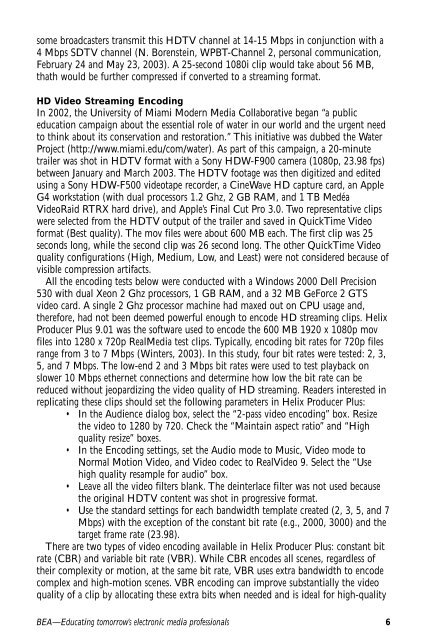JUNEFeedback
Issue 3 - Broadcast Education Association
Issue 3 - Broadcast Education Association
Create successful ePaper yourself
Turn your PDF publications into a flip-book with our unique Google optimized e-Paper software.
some broadcasters transmit this HDTV channel at 14-15 Mbps in conjunction with a4 Mbps SDTV channel (N. Borenstein, WPBT-Channel 2, personal communication,February 24 and May 23, 2003). A 25-second 1080i clip would take about 56 MB,thath would be further compressed if converted to a streaming format.HD Video Streaming EncodingIn 2002, the University of Miami Modern Media Collaborative began “a publiceducation campaign about the essential role of water in our world and the urgent needto think about its conservation and restoration.” This initiative was dubbed the WaterProject (http://www.miami.edu/com/water). As part of this campaign, a 20-minutetrailer was shot in HDTV format with a Sony HDW-F900 camera (1080p, 23.98 fps)between January and March 2003. The HDTV footage was then digitized and editedusing a Sony HDW-F500 videotape recorder, a CineWave HD capture card, an AppleG4 workstation (with dual processors 1.2 Ghz, 2 GB RAM, and 1 TB MedéaVideoRaid RTRX hard drive), and Apple’s Final Cut Pro 3.0. Two representative clipswere selected from the HDTV output of the trailer and saved in QuickTime Videoformat (Best quality). The mov files were about 600 MB each. The first clip was 25seconds long, while the second clip was 26 second long. The other QuickTime Videoquality configurations (High, Medium, Low, and Least) were not considered because ofvisible compression artifacts.All the encoding tests below were conducted with a Windows 2000 Dell Precision530 with dual Xeon 2 Ghz processors, 1 GB RAM, and a 32 MB GeForce 2 GTSvideo card. A single 2 Ghz processor machine had maxed out on CPU usage and,therefore, had not been deemed powerful enough to encode HD streaming clips. HelixProducer Plus 9.01 was the software used to encode the 600 MB 1920 x 1080p movfiles into 1280 x 720p RealMedia test clips. Typically, encoding bit rates for 720p filesrange from 3 to 7 Mbps (Winters, 2003). In this study, four bit rates were tested: 2, 3,5, and 7 Mbps. The low-end 2 and 3 Mbps bit rates were used to test playback onslower 10 Mbps ethernet connections and determine how low the bit rate can bereduced without jeopardizing the video quality of HD streaming. Readers interested inreplicating these clips should set the following parameters in Helix Producer Plus:• In the Audience dialog box, select the “2-pass video encoding” box. Resizethe video to 1280 by 720. Check the “Maintain aspect ratio” and “Highquality resize” boxes.• In the Encoding settings, set the Audio mode to Music, Video mode toNormal Motion Video, and Video codec to RealVideo 9. Select the “Usehigh quality resample for audio” box.• Leave all the video filters blank. The deinterlace filter was not used becausethe original HDTV content was shot in progressive format.• Use the standard settings for each bandwidth template created (2, 3, 5, and 7Mbps) with the exception of the constant bit rate (e.g., 2000, 3000) and thetarget frame rate (23.98).There are two types of video encoding available in Helix Producer Plus: constant bitrate (CBR) and variable bit rate (VBR). While CBR encodes all scenes, regardless oftheir complexity or motion, at the same bit rate, VBR uses extra bandwidth to encodecomplex and high-motion scenes. VBR encoding can improve substantially the videoquality of a clip by allocating these extra bits when needed and is ideal for high-qualityBEA—Educating tomorrow’s electronic media professionals 6
















